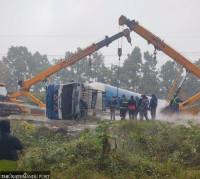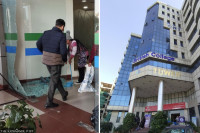National
Justice Raut-led panel fails to resolve dispute over law amendment
As the panelists remained divided, two separate reports were presented to Chief Justice Shrestha making the appointment of judges uncertain.
Post Report
The panel formed to resolve disputes over an amendment to the Judicial Council Regulations has failed to find a meeting point with the Nepal Bar Association refusing to budge from its demand to revert the changes.
Following the protest from the lawyers’ umbrella body, the leadership in the judiciary constituted a five-member committee on September 2 to settle the matter through dialogue. Prakash Man Singh Raut, the senior-most justice of the Supreme Court, led the panel.
Ram Prasad Bhandari, a member of the council, Gopal Krishna Ghimire, and Anjita Khanal, president and general secretary of the association respectively, and Yam Bahadur Budha, secretary at the council, were members of the panel.
Despite 10 days of effort, the Raut-led panel couldn’t resolve the dispute. Raut and Bhandari disagreed with the association’s demand to revert the amendment, while Budha remained neutral. As a result, two separate reports have been presented to Chief Justice Bishowambhar Shrestha.
“Scrapping the amendment to the regulation is our bottom line. We [Ghimire and Khanal] presented a separate report as the other side didn’t agree to our demands,” said Ghimire. “Now it is up to the chief justice to find a solution.”
The council revised the regulations in September 2023, adjusting the judges’ ranking. According to the amendment published in the Nepal Gazette on September 20 last year, the chief registrar of the Supreme Court or the council secretary, if appointed a high court judge, would be ranked right after the chief judge of the high court.
The association has demanded that the provision be revoked, describing it as regressive, biased, discriminatory, arbitrary, and unconstitutional and arguing that it contradicts the principles established by Supreme Court’s verdicts. On September 1, the association started a sit-in demanding that judges be appointed only after revising the provision.
The protest was called off with an agreement to form the Raut-led committee.
The lawyers’ body had started the protests as the council was making final preparations to appoint judges across three layers of courts. While four judges’ positions are vacant in the Supreme Court, 16 judges are needed in various high courts.
The five-member Judicial Council, led by the chief justice, nominates judges and justices. The council includes the law minister, the senior-most Supreme Court justice, and two advocates—one each picked by the association and the government.
Against the association’s demand, the Judicial Officers Society wants to continue the existing provision in the regulation. Opposing the idea of forming the Raut-led panel, the society warned that any decision on legal matters must be made in court, not on the streets. The society is an association of the officials working under the judicial services.
The appointment of judges has become uncertain, as the council’s leadership has been caught in the two associations’ contradictory demands.
In December last year, the council appointed Lal Bahadur Kunwar, the Supreme Court chief registrar, a high court judge and ranked him second after the chief judge of Patan High Court. The association claims that the amended regulation unfairly demotes judges appointed from among lawyers, placing them below career judges in the hierarchy.
There was a practice of filling around half the vacant judge positions from among lawyers. However, Chief Justice Shrestha gave them less priority, which was also a reason for the protest.
In January, 26 district court judges were promoted to high court positions. Four joint secretary-level officials from the judicial service were also picked as high court judges. But only nine lawyers were appointed judges. The association had demanded that half the judges be appointed from among the lawyers.
In the judicial hierarchy, those appointed to the high court from the lawyers’ category are ranked below those promoted from among district court judges or those picked from the judicial service.
“We will devise our future course based on the chief justice’s action,” said Ghimire. As the chief justice retires on October 6, he wants to fill the vacant positions before that.




 7.12°C Kathmandu
7.12°C Kathmandu












%20(1).jpg&w=300&height=200)

